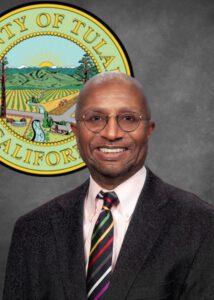 An Op-Ed written by Dr. Lester E. Love is the Medical Director for Tulare County Health & Human Services Agency’s Mental Health Branch
An Op-Ed written by Dr. Lester E. Love is the Medical Director for Tulare County Health & Human Services Agency’s Mental Health Branch
First, my friend took a drink.
Then the drink took a drink.
Then the drink took my friend.
Many 12-step groups have memorialized this ancient Eastern proverb. It adeptly captures the sneaky, bewildering, gradually increasing, and highly challenging nature of addiction—a demanding topic that has become prominent, along with the horror of a global pandemic.
Toward the end of 2019, a previously unidentified coronavirus, Severe Acute Respiratory Syndrome Coronavirus 2 (SARS-CoV-2), burst onto the world stage. The virus and the disease associated with this novel coronavirus strain eventually became widely known as COVID-19. COVID-19 quickly spread around the world, sparking unlimited international public health concerns, and ultimately, in 2020, the World Health Organization (WHO) determined that these events were the symptoms of a pandemic. In attempts to control the pandemic, governments worldwide, including the United States, implemented social distancing and stay-at-home measures, resulting in millions of people being isolated at home, deeply cut off from all usual means of entertainment and support. Never in the modern world have such ongoing disease-control policies been adopted.
Both people’s personal experience and clinical research show that COVID-19, and our determination to eliminate the virus, have been associated with increased levels of fear, anxiety, nervousness, stress, depression, and irritability—in addition to increases in alcohol and drug misuse and abuse, and also drug overdoses and overdose-related deaths. Medical providers have concluded that many of these psychological, substance use, and addictive disorders can be severe and enduring for some individuals.
Though often considered to be mainly a problem of large, metropolitan cities, a recent report published by the Centers for Disease Control showed the sizable impact of alcohol, tobacco, and illicit substance misuse on rural communities like Tulare County. In rural communities in the United States, adults have higher alcohol, tobacco, and methamphetamine misuse and abuse rates. At the same time, prescription drug abuse and heroin use have grown in towns of every size. More specifically, according to The 2014 Update of the Rural-Urban Chartbook, the substance abuse treatment admission rate for rural counties was highest for alcohol as the primary substance, followed by marijuana, stimulants, opiates, and cocaine.
Many rural areas face a high burden of substance use disorders, in part due to unique risk factors such as:
- Geographic isolation
- Increased risk behaviors
- Lower levels of education
- Higher rates of poverty
- Higher rates of unemployment
- A shortage of mental health providers, services, and facilities
- Increased availability of legally and illegally obtained prescription opioids in recent years
Substance abuse can be incredibly difficult to combat in rural communities due to limited resources for health, prevention, treatment, and recovery. As is true with many physical and behavioral health services and supports, the need for access and treatment and for the expertise needed to treat is far greater than what is available in rural communities. Without access to evidence-based treatments, support services for long-term recovery, and continuing technical assistance for health care providers and professionals, addiction throws individuals and families—sometimes quickly, sometimes slowly—into crisis.
The research is unquestionable. Among the strongest evidence-based treatments is Medication-Assisted Treatment (MAT), also referred to as “medications for addiction treatment.” Staying clean, in recovery, and free from relapse is often more than twice as likely with medications as without them. When thoroughly implemented, MAT promotes recovery and improves people’s health and social function in their families, schools, workplaces, and communities. MAT does this by:
- Decreasing withdrawal symptoms
- Blocking the euphoric (ecstatic or “high”) effects of opioids, alcohol, and tobacco
- Inhibiting cravings
- Keeping people in treatment
- Preventing relapse and overdose death
- Promoting a sense of community and support
MAT effectively combines psychosocial therapy (at a minimum, a thorough psychosocial needs assessment, supportive counseling, links to existing family supports, and referrals to community services) with medication, typically in an outpatient setting. This methodology represents a “whole-patient” approach to treating addictive disorders.
We are happy to announce that fully implemented MAT services will be available at Tulare County’s Visalia Recovery Center in the next few months. Tulare County Alcohol and Other Drug (AOD) prevention, treatment, and recovery programs are dedicated to serving the residents and families of Tulare County who experience the effects of substance use disorders. To date, services have included outpatient and residential treatment for men and women provided by certified alcohol and other drug treatment specialists; now we are expanding these services by bringing onboard medical professionals and psychiatrists who will offer MAT services and inclusive mental health assessments.
There is hope. See for yourself how Tulare County Mental Health and AOD programs are at the leading edge of innovations, transforming health care, positively affecting the lives of families, building community, and improving the health of individuals of all ages.
ABOUT THE AUTHOR: Dr. Lester E. Love is the Medical Director for Tulare County Health & Human Services Agency’s Mental Health Branch. He also serves as Core Faculty and Director of the Psychiatric Outpatient Residency Training Program at Kaweah Delta Health Care District. For Substance Abuse and other Mental Health Services please contact Tulare County HHSA at 1-866-732-4114 or visit https://tchhsa.org/eng/index.cfm/mental-health/
